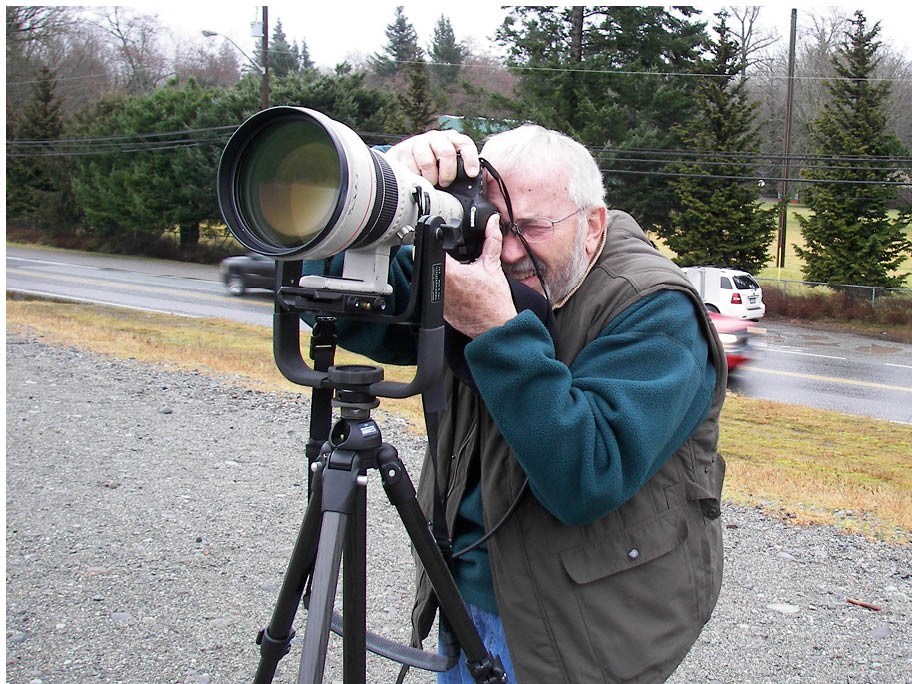With his super long lens and his Canon camera on a tripod Dave Dilworth of Plano, Texas was all set to capture photos of eagles in Squamish last weekend while volunteers recorded 655 eagles as part of the annual eagle count.
While Dilworth snapped photos of the eagles roosting in the trees on the west side of the Squamish River on Sunday (Jan. 8) Squamish Eagle Count volunteers were spread throughout the community recording the eagles spotted in the valley.
When planning their trip the eagle viewing options for Dilworth and his wife were Squamish and Alaska, but Alaska is a much longer trip so they chose to see the eagles of Squamish.
Dilworth described himself as a hobby photographer, purchasing his gear from EBay before the couple set off on their travels to find and photograph eagles in large numbers.
"Where we live we see them but not in numbers like you have here," he said with just a hint of Texas drawl.
The number of eagles counted this year is consistent with past years. This was an average year under average weather conditions consisting of low cloud, mist conditions and occasional drizzle.
"Your weather is supposed to get better on Tuesday," Dilworth said hopefully.
He and his wife stayed at a Squamish hotel intending to remain in town until the sun came out so Dilworth could get some blue-sky photos of eagles.
Bob Brant, an Eagle Watch volunteer, said he meets at least one person who has come to Squamish specifically to see eagles each time he takes a shift on the Eagle Run dike in Brackendale to answer questions about the majestic birds.
Following his Sunday shift on the dike, Brant met his wife at the Brackendale Art Gallery where Thor and Dorte Froslev have hosted the annual eagle count for the last 26 years.
The volunteers involved in the counting effort set out early in the morning to tally all the eagles spotted from the tip of Howe Sound north to the Elaho River and east up the Mamquam River.
The annual count, which is held on the first Sunday of the year, is a barometer that offers a fact-based look at the health of the eagle population, said Froslev.
The count gives the science world a glimpse into the overall health of the area, he added.
In 1994 the counters spotted 2,422 eagles and between 1998 and 2007 the count fell below 1,000 eagles only once. Between 2008 and 2010 the counters found between 500 and 700 eagles. Last year was a poor weather year in which counters spotted only 432 eagles. The only year counters spotted fewer eagles was in 1986 when 408 eagles were found in the first year of the count.
The average number of eagles counted in the 25 years of the event was 1,597.
Froslev, a member of the Squamish Streamkeepers group, said the salmon population in Squamish has declined and he believes fewer salmon means fewer eagles. He shared his theory of what is bringing down the salmon population in Squamish.
"I believe it is the fish farms that is to blame for all of that," he said after the count wrapped up. According to Froslev, sea lice are infecting native salmon populations and he believes the lice come from fish farm operations along the coast.
According to the B.C. Salmon Farmers Association, extensive research shows that mature Pacific salmon are resistant to damage from sea lice.
The Department of Fisheries and Oceans (DFO) currently has the following statement posted on its website: "There continues to be surges of (mis) information circulated about sea lice and its impact on aquaculture in B.C., and more specifically the Broughton Archipelago. DFO is committed to protecting our finfish stocks, both farmed and wild. With this commitment in mind DFO researchers and scientists work diligently to ensure the safety and sustainability of both aquaculture and wild salmon fisheries."
A total of 53 volunteer eagle counters spent the morning tallying eagles and other birds. The volunteer team also spotted hawks, swans, blue heron, kingfishers, a goshawk, dippers and ducks.




